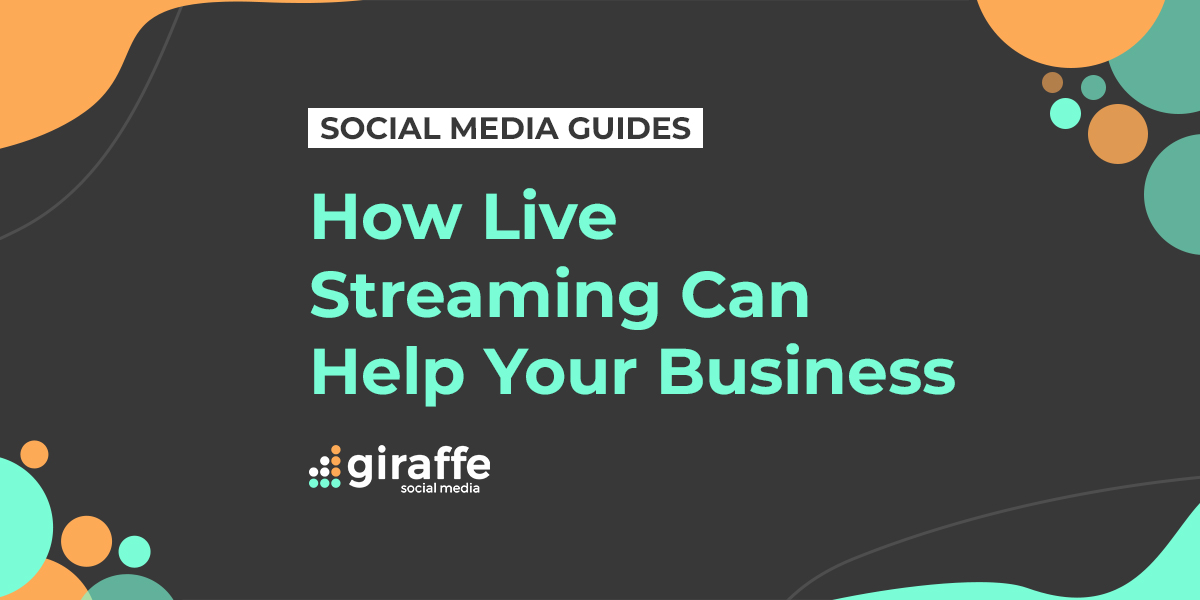Live streaming can sometimes seem challenging, especially if you’re trying to use it for business. But the benefits of an effective live stream are unparalleled. This guide goes back to basics and answers some common live streaming FAQs to help you use live video to smash your social marketing goals.
For a long time, the only way to engage with customers in a personal, real-time way was via traditional, in-store interaction. Social media has, in recent years, become a great middle-ground, making digital brand interaction much more accessible. However social content, like other marketing activity, usually goes through a net of signoffs and editing. These processes are essential but limit the potential for authentic customer interaction.
Enter the live-streamed video, an exciting medium which gives brands and individuals a direct line to their audience and potential customers. This isn’t just a powerful tool for building your brand, it’s the content your audience wants to see. Research shows that 80% of consumers prefer to watch live videos from a brand than read a blog. Who can blame them? What’s easier or more engaging to watch than an unfiltered video where anything could happen?

When did everyone start live streaming?
YouTube was unsurprisingly the first social media platform to venture into the world of live internet video. It launched its YouTube Live feature in 2011, which gradually became available to all users. The medium gathered momentum as Twitter acquired streaming service Periscope in 2015. This enabled its users to tweet direct links to their live stream. In 2016, Facebook took the live movement to the next level by giving its huge active user base (then already 1.09 billion) the ability to go Facebook Live. Naturally, Instagram followed shortly after.
The appeal is simple. There’s a thrill to being able to see what your favourite celebrity, acquaintance or brand are doing at that very moment. Users can see what’s happening in Paris or the House of Commons or Cardi B’s house from wherever they are in the world. Plus, live streaming lets users communicate directly with the accounts they follow via a live comments section.

How can live streaming help my business?
The possibilities for sports and entertainment providers are obvious. But how can live streaming be useful for businesses like yours? Well, that depends on what you offer. A good exercise would be to sit down and look at what emotional benefits your brand provides. Then see how live streaming can amplify your offering.
A financial provider might be seeking to educate, so could look at delivering expert informational videos and Q&As. A fashion brand could be trying to make their customers feel glamourous and at the cutting edge of fashion, they could offer live, exclusive sneak peeks at their latest collection. An exercise-related brand could stream live fitness classes or cooking tutorials to encourage wellness. Live streaming is a great way to build your audience’s brand sentiment, establish your company and its representatives as experts and build a community.
There are plenty of great examples of how a variety of businesses, from beauty brands to exterminators, are already making great use of live video. Why not use your competitors for inspiration?
Live Streaming FAQs
Where should I live stream?
It’s best to start with the bigger platforms, as this is probably where you already have the most significant number of existing followers. Facebook, LinkedIn and Instagram have easy-to-use set-ups in place, which will help get you started.
Like the rest of your social media activity, you should be streaming to where your audience is already hanging out online. Our favourite scheduling software provider, Sprout, has a great demographics guide if you haven’t already figured this out.
How should I structure my live stream?
An aimless video will turn users off just as quickly as they clicked on. Planning a trajectory for your video, like a top ten or several key talking points will keep you on the right track. If you’re going to be live for more than ten minutes, you need to ask yourself, why? Short and sweet live videos keep people interested and work better if shared again later as static content.
How do I engage with live viewers?
The fundamental rule of live streaming is don’t forget about your audience. It’s easy to get nervous and plough through your planned talking points. But if you don’t engage with the viewers who’ve made an effort to show up, you’ll probably end up doing more harm than good. No one likes to feel ignored, after all. Ask your audience questions, address them directly, say hi to and thank individual users that pop up.
How do I get more viewers on my live stream?
Going live is an event, so you should treat it like one. Letting your audience know in advance is a crucial way to maximise viewership. There are two ways you can do this. One is to post on your channels in the days leading up to the live stream to inform your already engaged audience. For the best results, you should look at running ads too.
The second way you can promote your live stream, which works best on Facebook, is by organising an event. This way you can invite your friends and followers, see who’s ‘interested’ or ‘going’ and then live stream direct from the event page. Rumour has it that Instagram might be launching a new ‘plans’ feature, which could enable this strategy soon too.
Is there a quick way to boost engagement?
A common anxiety when planning a live stream is that no-one will show up, or if they do, that they won’t talk to you. Unfortunately, it does happen. And it’s natural while you’re still figuring your audience out.
Developing genuinely interesting content is the best way to boost engagement long-term. However, you can’t go wrong with the occasional giveaway. Offering the chance for a viewer to receive something palpable (over and above your really useful content – of course) practically guarantees engagement. Ask them to comment a question or tag a friend to be entered into a prize draw, then watch the comments roll in.
What is multicasting?
Multicasting, or simulcasting as it’s also known, describes the use of third-party technology or multiple devices to broadcast to different platforms simultaneously. There can be benefits to doing this, but there are also plenty of risks. The main drawback is that it can disillusion your audience. The key selling point of live streaming is that it’s an intimate experience. Multicasting can be a bit like sending the same heartfelt message to all of your romantic prospects. They might not be too happy when they find out.
Another negative of this approach is that social media isn’t a one-size-fits-all landscape. At Giraffe Social Media, we know the best way to kill it on social is to have a dedicated strategy optimised for each channel. The copy and paste approach isn’t going to get you as far as you think it is. To build an engaged following on multiple platforms, you have to give your potential customers reasons to follow you on each one.
This year live streaming is expected to account for 82% of all internet traffic. If you aren’t already live streaming, now is the perfect time to hit record.
For more guidance on live streaming or social media in general, get in touch with our expert team using the contact tab above.





